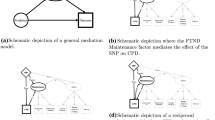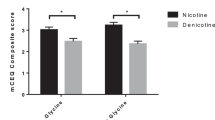Abstract
Rationale
Cigarette smoking is influenced by nicotine’s effects on dopaminergic activity in the mesocorticolimbic pathway. This activity appears to be moderated by genetic variation, specifically a variable number tandem repeat (VNTR) polymorphism in the third exon of the dopamine receptor gene (DRD4).
Objective
We examined whether this polymorphism along with three DRD4 single-nucleotide polymorphisms (SNPs: rs936460, rs936461, and rs12280580) moderate the influence of nicotine on subjective responses to cigarettes.
Methods
White, non-Hispanic smokers (n = 96, cigarettes/day ≥15) attended two double-blind, counterbalanced experimental sessions, each preceded by overnight smoking abstinence. Participants smoked four nicotine (8.9 mg) or placebo (1.0 mg) cigarettes per session, with each cigarette followed by completion of the modified Cigarette Evaluation Questionnaire (mCEQ).
Results
We examined the mCEQ composite score via 2 × 2 × 4 ANOVAs with genotype (major homozygotes versus minor carriers) as the between-subject factor and nicotine content and smoking bout as within-subject factors. Although DRD4 VNTR variation did not moderate overall nicotine response, there was a moderation of nicotine response over successive cigarettes. Smokers with fewer than seven repeats for the DRD4 VNTR reported markedly reduced craving, increased satisfaction, and a greater calming effect in response to earlier smoked nicotine cigarettes, whereas those with seven or more repeats did not. In addition, minor carriers for all three DRD4 SNPs displayed blunted overall response to nicotine.
Conclusion
These findings provide support for DRD4 variation as an informative predictor of subjective responses to nicotine. We discuss how these data may lead to improved tailoring of smoking cessation pharmacotherapies.



Similar content being viewed by others
References
Asghari V, Sanyal S, Buchwaldt S, Paterson A, Jovanovic V, Van Tol HH (1995) Modulation of intracellular cyclic AMP levels by different human dopamine D4 receptor variants. J Neurochem 65:1157–1165
Bergen AW, Javitz HS, Su L, He Y, Conti DV, Benowitz NL, Tyndale RF, Lerman C, Swan GE (2013) The DRD4 exon III VNTR, bupropion, and associations with prospective abstinence. Nicotine Tob Res 15:1190–1200
Bierut LJ, Johnson EO, Saccone NL (2014) A glimpse into the future - Personalized medicine for smoking cessation. Neuropharmacology 76 Pt B:592–599
Brody AL, Mandelkern MA, Olmstead RE, Scheibal D, Hahn E, Shiraga S, Zamora-Paja E, Farahi J, Saxena S, London ED, McCracken JT (2006) Gene variants of brain dopamine pathways and smoking-induced dopamine release in the ventral caudate/nucleus accumbens. Arch Gen Psychiatry 63:808–816
Cappelleri JC, Bushmakin AG, Baker CL, Merikle E, Olufade AO, Gilbert DG (2007) Confirmatory factor analyses and reliability of the modified cigarette evaluation questionnaire. Addict Behav 32:912–923
CDC (2011) Quitting smoking among adults—United States, 2001–2010. MMWR Morb Mortal Wkly Rep 60:1513–1519
David SP, Munafo MR (2008) Genetic variation in the dopamine pathway and smoking cessation. Pharmacogenomics 9:1307–1321
David SP, Munafo MR, Murphy MF, Proctor M, Walton RT, Johnstone EC (2008) Genetic variation in the dopamine D4 receptor (DRD4) gene and smoking cessation: follow-up of a randomised clinical trial of transdermal nicotine patch. Pharmacogenomics J 8:122–128
Di Chiara G (2000) Role of dopamine in the behavioural actions of nicotine related to addiction. Eur J Pharmacol 393:295–314
Epping-Jordan MP, Watkins SS, Koob GF, Markou A (1998) Dramatic decreases in brain reward function during nicotine withdrawal. Nature 393:76–79
Evans DE, Maxfield ND, Van Rensburg KJ, Oliver JA, Jentink KG, Drobes DJ (2013) Nicotine deprivation influences P300 markers of cognitive control. Neuropsychopharmacology 38:25252531
Evans DE, Sutton SK, Oliver JA, Drobes DJ (2014) Cortical activity differs during nicotine deprivation versus satiation in heavy smokers. Psychopharmacology
Fava M, Papakostas GI, Petersen T, Mahal Y, Quitkin F, Stewart J, McGrath P (2003) Switching to bupropion in fluoxetine-resistant major depressive disorder. Ann Clin Psychiatry 15:17–22
Federal Trade Commission (2000). “Tar,” nicotine, and carbon monoxide of the smoke of 1294 varieties of domestic cigarettes for the year 1998. Washington, DC.
Girault JA, Greengard P (2004) The neurobiology of dopamine signaling. Arch Neurol 61:641644
Gottesman II, Gould TD (2003) The endophenotype concept in psychiatry: etymology and strategic intentions. Am J Psychiatry 160:636–645
Hack LM, Kalsi G, Aliev F, Kuo PH, Prescott CA, Patterson DG, Walsh D, Dick DM, Riley BP, Kendler KS (2011) Limited associations of dopamine system genes with alcohol dependence and related traits in the Irish Affected Sib Pair Study of Alcohol Dependence (IASPSAD). Alcohol Clin Exp Res 35:376–385
Harrell PT, Juliano LM (2012) A direct test of the influence of nicotine response expectancies on the subjective and cognitive effects of smoking. Exp Clin Psychopharmacol 20:278–286
Hayford KE, Patten CA, Rummans TA, Schroeder DR, Offord KP, Croghan IT, Glover ED, Sachs DP, Hurt RD (1999) Efficacy of bupropion for smoking cessation in smokers with a former history of major depression or alcoholism. Br J Psychiatry 174:173–178
Heatherton TF, Kozlowski LT, Frecker RC, Fagerstrom K (1991) The Fagerstrom test for nicotine dependence: a revision of the Fagerstrom Tolerance Questionnaire. Br J Addict 86:1119–1127
Herman AI, DeVito EE, Jensen KP, Sofuoglu M (2014) Pharmacogenetics of nicotine addiction: role of dopamine. Pharmacogenomics 15:221–234
Hutchison KE, LaChance H, Niaura R, Bryan A, Smolen A (2002) The DRD4 VNTR polymorphism influences reactivity to smoking cues. J Abnorm Psychol 111:134–143
Juliano LM, Fucito LM, Harrell PT (2011) The influence of nicotine dose and nicotine dose expectancy on the cognitive and subjective effects of cigarette smoking. Exp Clin Psychopharmacol 19:105–115
Kalivas PW, Volkow ND (2005) The neural basis of addiction: a pathology of motivation and choice. Am J Psychiatry 162:1403–1413
Kelemen WL, Kaighobadi F (2007) Expectancy and pharmacology influence the subjective effects of nicotine in a balanced-placebo design. Exp Clin Psychopharmacol 15:93
Koks S, Nikopensius T, Koido K, Maron E, Altmae S, Heinaste E, Vabrit K, Tammekivi V, Hallast P, Kurg A, Shlik J, Vasar V, Metspalu A, Vasar E (2006) Analysis of SNP profiles in patients with major depressive disorder. Int J Neuropsychopharmacol 9:167–174
Kollins SH, Anastopoulos AD, Lachiewicz AM, FitzGerald D, Morrissey-Kane E, Garrett ME, Keatts SL, Ashley-Koch AE (2008) SNPs in dopamine D2 receptor gene (DRD2) and norepinephrine transporter gene (NET) are associated with continuous performance task (CPT) phenotypes in ADHD children and their families. Am J Med Genet B Neuropsychiatr Genet 147B:1580–1588
Laucht M, Becker K, El-Faddagh M, Hohm E, Schmidt MH (2005) Association of the DRD4 exon III polymorphism with smoking in fifteen-year-olds: a mediating role for novelty seeking? J Am Acad Child Adolesc Psychiatry 44:477–484
Laucht M, Becker K, Blomeyer D, Schmidt MH (2007) Novelty seeking involved in mediating the association between the dopamine D4 receptor gene exon III polymorphism and heavy drinking in male adolescents: results from a high-risk community sample. Biol Psychiatry 61:8792
Le Foll B, Gallo A, Le Strat Y, Lu L, Gorwood P (2009) Genetics of dopamine receptors and drug addiction: a comprehensive review. Behav Pharmacol 20:1–17
Lerman C, Caporaso N, Main D, Audrain J, Boyd NR, Bowman ED, Shields PG (1998) Depression and self-medication with nicotine: the modifying influence of the dopamine D4 receptor gene. Health Psychol 17:56–62
Leventhal AM, David SP, Brightman M, Strong D, McGeary JE, Brown RA, Lloyd-Richardson EE, Munafo M, Uhl GR, Niaura R (2012) Dopamine D4 receptor gene variation moderates the efficacy of bupropion for smoking cessation. Pharmacogenomics J 12:86–92
Leventhal AM, Lee W, Bergen AW, Swan GE, Tyndale RF, Lerman C, Conti DV (2014) Nicotine dependence as a moderator of genetic influences on smoking cessation treatment outcome. Drug Alcohol Depend 138:109–117
Macqueen DA, Heckman BW, Blank MD, Janse Van Rensburg K, Evans DE, Drobes DJ (2012) Transient compensatory smoking in response to placebo cigarettes. Psychopharmacology 223:47–54
McClernon FJ, Hutchison KE, Rose JE, Kozink RV (2007) DRD4 VNTR polymorphism is associated with transient fMRI-BOLD responses to smoking cues. Psychopharmacology 194:433–441
Mitsuyasu H, Kawasaki H, Ninomiya H, Kinukawa N, Yamanaka T, Tahira T, Stanton VP Jr, Springett GM, Hayashi K, Tashiro N, Kanba S (2007) Genetic structure of the dopamine receptor D4 gene (DRD4) and lack of association with schizophrenia in Japanese patients. J Psychiatr Res 41:763–775
Munafo MR, Johnstone EC (2008) Smoking status moderates the association of the dopamine D4 receptor (DRD4) gene VNTR polymorphism with selective processing of smoking-related cues. Addict Biol 13:435–439
Munafo MR, Murphy MF, Johnstone EC (2006) Smoking cessation, weight gain, and DRD4–521 genotype. Am J Med Genet B Neuropsychiatr Genet 141B:398–402
Nikolaidis A, Gray JR (2010) ADHD and the DRD4 exon III 7-repeat polymorphism: an international meta-analysis. Soc Cogn Affect Neurosci 5:188–193
Nyman ES, Ogdie MN, Loukola A, Varilo T, Taanila A, Hurtig T, Moilanen IK, Loo SK, McGough JJ, Jarvelin MR, Smalley SL, Nelson SF, Peltonen L (2007) ADHD candidate gene study in a population-based birth cohort: association with DBH and DRD2. J Am Acad Child Adolesc Psychiatry 46:1614–1621
Perkins KA, Lerman C, Grottenthaler A, Ciccocioppo MM, Milanak M, Conklin CA, Bergen AW, Benowitz NL (2008) Dopamine and opioid gene variants are associated with increased smoking reward and reinforcement owing to negative mood. Behav Pharmacol 19:641–649
Ray LA, Bryan A, Mackillop J, McGeary J, Hesterberg K, Hutchison KE (2009) The dopamine D Receptor (DRD4) gene exon III polymorphism, problematic alcohol use and novelty seeking: direct and mediated genetic effects. Addict Biol 14:238–244
Rivera A, Cuellar B, Giron FJ, Grandy DK, de la Calle A, Moratalla R (2002) Dopamine D4 receptors are heterogeneously distributed in the striosomes/matrix compartments of the striatum. J Neurochem 80:219–229
Thomson CJ, Rajala AK, Carlson SR, Rupert JL (2014) Variants in the dopamine-4-receptor gene promoter are not associated with sensation seeking in skiers. PLoS One 9:e93521
USDHHS (2014) The Health Consequences of Smoking-50 Years of Progress: A Report of the Surgeon General. U.S. Department of Health and Human Services, Centers for Disease Control and Prevention, National Center for Chronic Disease Prevention and Health Promotion, Office on Smoking and Health: Atlanta, GA
Volkow ND, Fowler JS, Wang G-J, Swanson JM, Telang F (2007) Dopamine in drug abuse and addiction: results of imaging studies and treatment implications. Arch Neurol 64:1575–1579
Wang E, Ding YC, Flodman P, Kidd JR, Kidd KK, Grady DL, Ryder OA, Spence MA, Swanson JM, Moyzis RK (2004) The genetic architecture of selection at the human dopamine receptor D4 (DRD4) gene locus. Am J Hum Genet 74:931–944
Warner C, Shoaib M (2005) How does bupropion work as a smoking cessation aid? Addict Biol 10:219–231
Watkins SS, Koob GF, Markou A (2000) Neural mechanisms underlying nicotine addiction: acute positive reinforcement and withdrawal. Nicotine Tob Res 2:19–37
Xu X, Clark US, David SP, Mulligan RC, Knopik VS, McGeary J, MacKillop J, McCaffery J, Niaura RS, Sweet LH (2014) Effects of nicotine deprivation and replacement on BOLD-fMRI response to smoking cues as a function of DRD4 VNTR genotype. Nicotine Tob Res 16:939–947
Acknowledgments
This work has been supported in part by the Molecular Genomics Core Facility and the Biostatistics Core Facility at the H. Lee Moffitt Cancer Center & Research Institute, a NCI designated Comprehensive Cancer Center (P30-CA76292), as well as by the National Cancer Institute Behavioral Oncology Training Grant (R25CA090314) at Moffitt Cancer Center in Tampa, FL, awarded to Paul Jacobsen, and by grants R21DA027001 and R21DA024226, awarded to David Evans and David Drobes, respectively. The authors would also like to thank Renee Ornduff and Natasha Garcia for their work on this project.
Author contribution
DE and DD were responsible for the original study concept and design. DE and PH were responsible for secondary analysis study concept and design. PH completed data analysis and drafted the manuscript in collaboration with DE. DD and MB provided critical revisions to the manuscript. JP provided genotyping and genetic consultation. HL provided genetic and statistical consultation. All authors contributed to the manuscript and approved final version for publication.
Author information
Authors and Affiliations
Corresponding author
Ethics declarations
Funding
This study was funded by NIH grants R21 DA027001 and R21 DA024226.
Rights and permissions
About this article
Cite this article
Harrell, P.T., Lin, HY., Park, J.Y. et al. Dopaminergic genetic variation moderates the effect of nicotine on cigarette reward. Psychopharmacology 233, 351–360 (2016). https://doi.org/10.1007/s00213-015-4116-6
Received:
Accepted:
Published:
Issue Date:
DOI: https://doi.org/10.1007/s00213-015-4116-6




